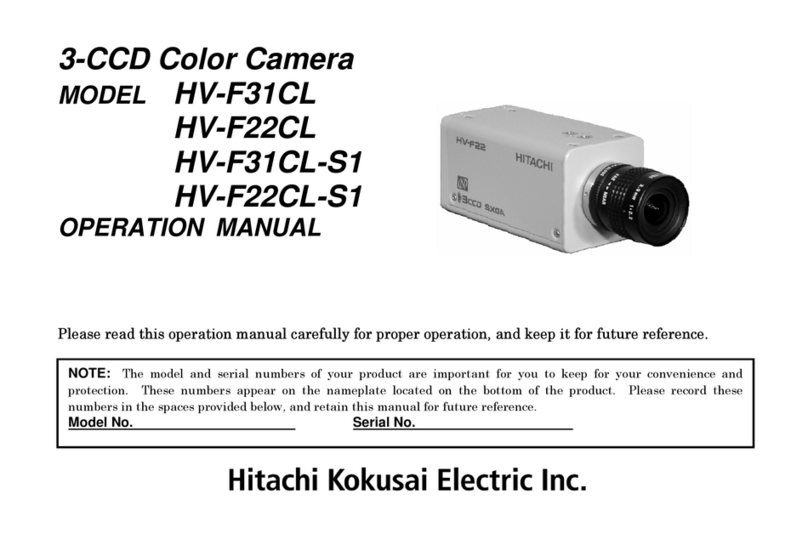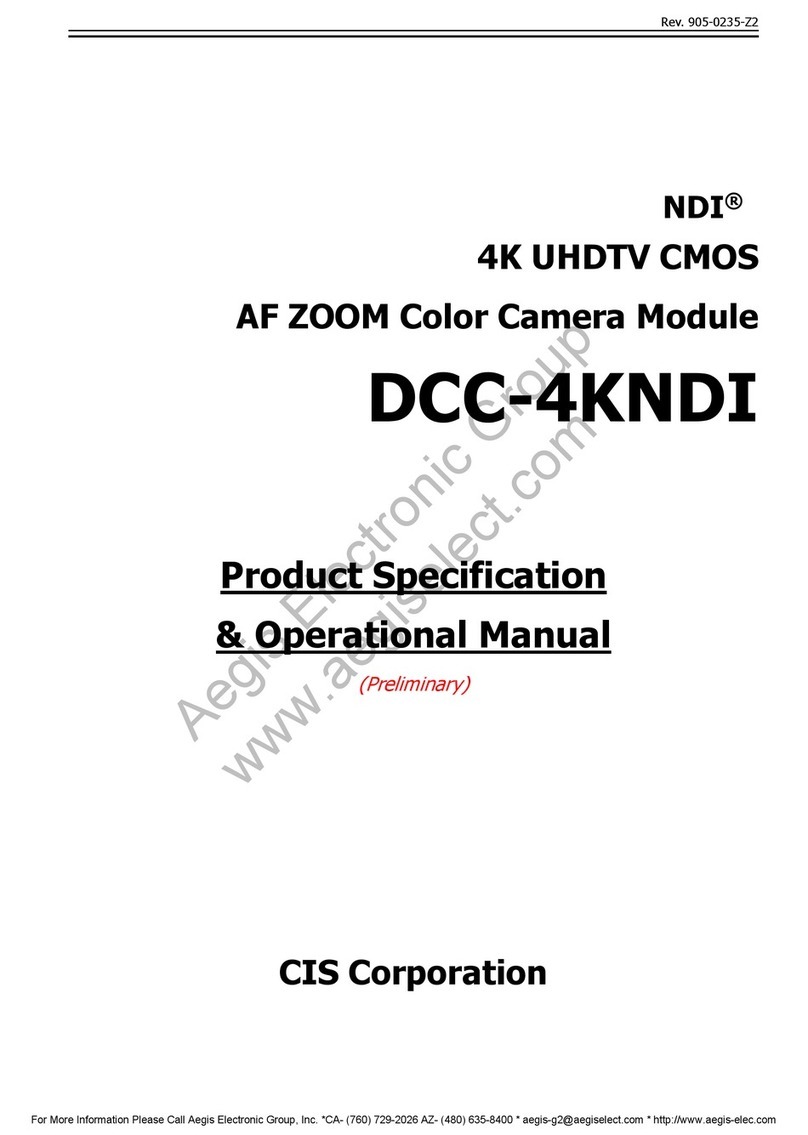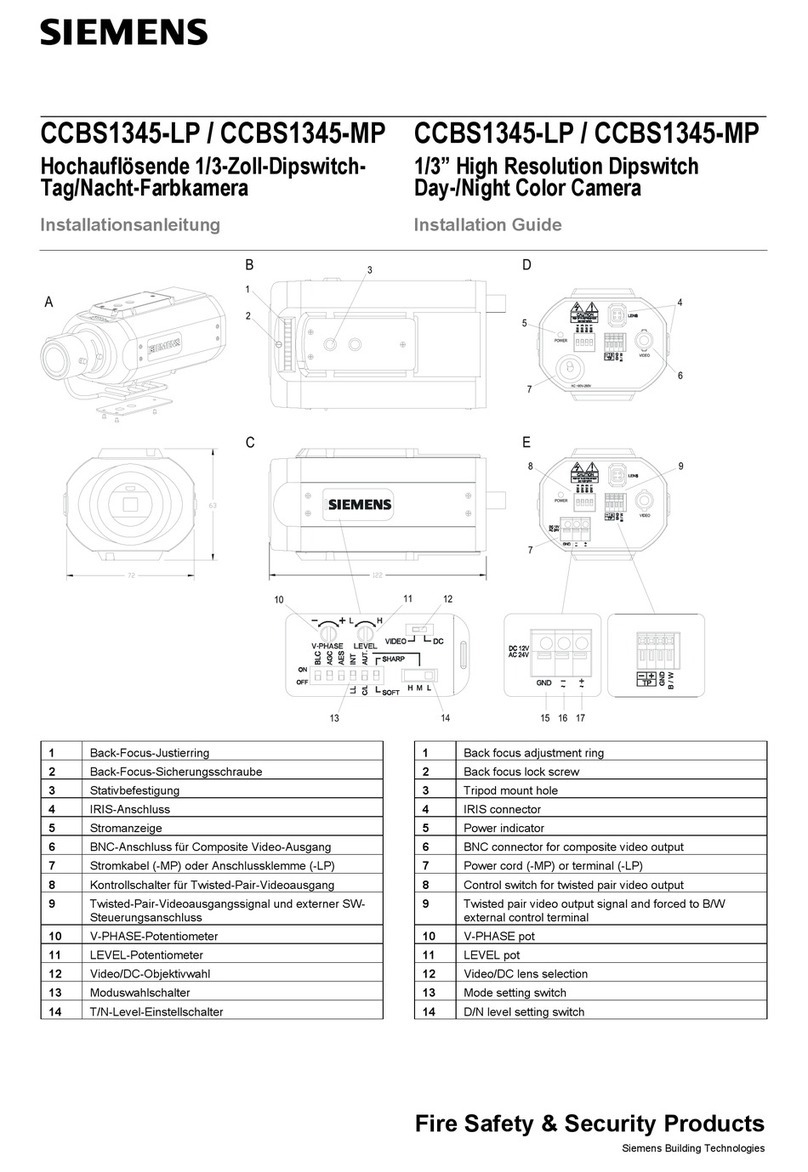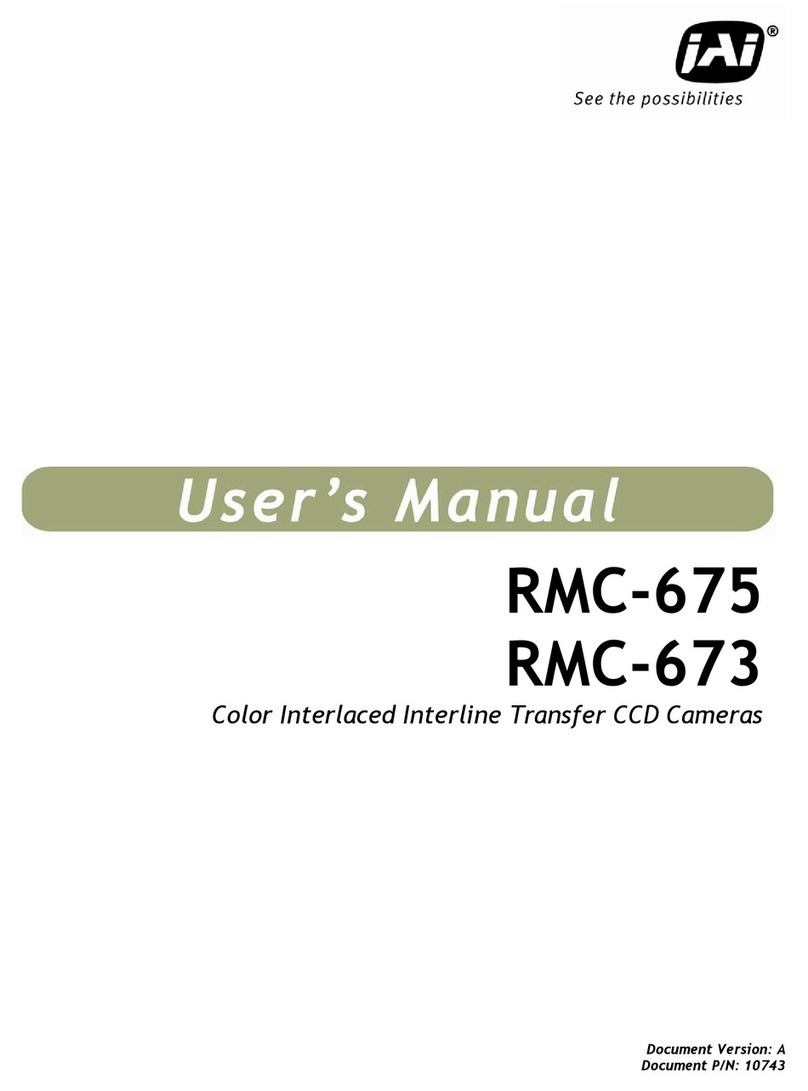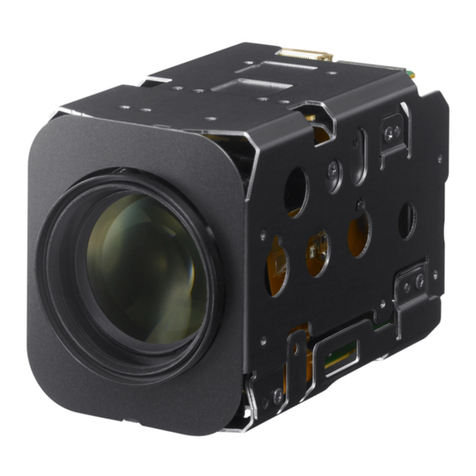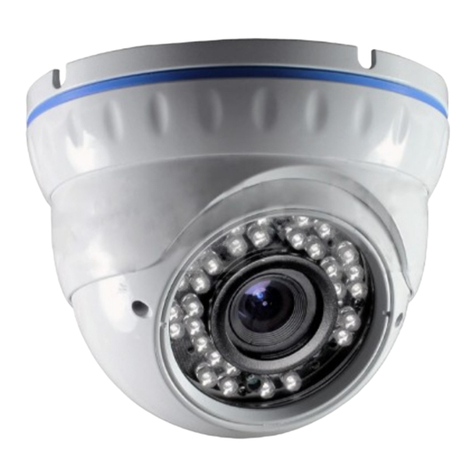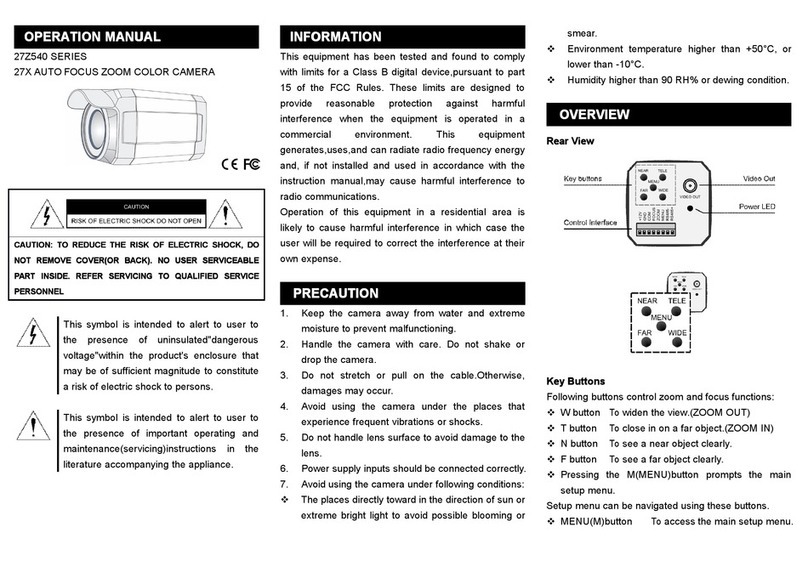Ros CE-X-36 User manual

TABLE OF CONTENTS
WARRANTY............................................................................................................................... IV
CUSTOMER ASSISTANCE ........................................................................................................ V
CHANGE RECORD.................................................................................................................... VI
1DESCRIPTION......................................................................................................................1
2CE-X, 36:1 CAMERA SPECIFICATIONS.............................................................................3
2.1POWER .......................................................................................................................................3
2.2CAMERA PERFORMANCE DATA..............................................................................................3
2.3DIMENSIONS..............................................................................................................................4
2.4WEIGHT (LESS CONNECTOR).........................................................................................................4
2.5MATERIALS.................................................................................................................................4
2.6ENVIRONMENTAL......................................................................................................................4
2.7STANDARD CE-X CONNECTORS.............................................................................................4
2.7.1Impulse LPMBH-6-MP.............................................................................................................4
2.7.2Impulse AG-306.......................................................................................................................5
2.7.3Impulse MHDG-9-BCR............................................................................................................5
2.7.4Impulse MSSJ-10-BCR ...........................................................................................................5
2.8CAMERA INTERCONNECTIONS...............................................................................................6
2.8.1Basic Interconnections (Bipolar Control).................................................................................6
2.8.2Cameras with Y/C and RS485 Control (Options)....................................................................6
2.8.3Other Configurations ...............................................................................................................7
2.9CAMERA MODE SELECTION.....................................................................................................7
2.9.1Mode Selection........................................................................................................................7
3CAMERA OPERATION......................................................................................................11
3.1GENERAL..................................................................................................................................11
3.2INSTALLATION .........................................................................................................................11
3.3EXPOSURE CONTROL.............................................................................................................11
3.4ZOOM CONTROL......................................................................................................................12
3.5FOCUS CONTROL....................................................................................................................12
3.6IMAGE FLIP CONTROL.............................................................................................................13
3.7NEGATIVE COLOR VIDEO CONTROL.....................................................................................13
3.8COMPUTER CONTROL............................................................................................................13
3.9LONG LINE AMPLIFICATION (LLA)..........................................................................................13
3.9.1Adjust LLA in Bipolar/Unipolar/Differential mode...................................................................14
3.9.2Adjust LLA in RS-232 mode..................................................................................................15
3.10OVERLAY CONTROL................................................................................................................15
4THEORY OF OPERATION.................................................................................................17
4.1UNIVERSAL INTERFACE BOARD ASSEMBLY .......................................................................17
4.1.1Reverse Polarity Protection...................................................................................................17
4.1.2Automatic Resettable Fuse Protection..................................................................................17
4.1.3Power Conditioning ...............................................................................................................17
4.1.4Standard Control Circuit Operation .......................................................................................17
4.1.5Video Signals.........................................................................................................................18
4.1.6Long Line Amplifier Circuit Operation....................................................................................18
4.1.7Microcontroller.......................................................................................................................19
5TROUBLESHOOTING........................................................................................................19
51-17568 REV B
II

5.1GENERAL..................................................................................................................................19
5.2CAMERA DISASSEMBLY.........................................................................................................20
5.3CAMERA OPERATIONAL CHECKS.........................................................................................20
5.4CAMERA TROUBLESHOOTING ..............................................................................................21
6MAINTENANCE..................................................................................................................22
APPENDIX..................................................................................................................................23
51-17568 REV B
III

51-17568 REV B
IV
WARRANTY
Remote Ocean Systems, Inc. (hereinafter called "ROS") warrants its products as stated below
subject to the conditions specified.
ROS warrants its products, when operated under normal conditions, to be free from defects in
material or workmanship for a periodof one yearfrom thedate of purchase provided that inspection
by ROS discloses that such defects developed under normal and proper use. ROS products
repaired or replaced pursuant to this warranty shall be warranted for the unexpired portion of the
warranty applying to the original product. The liability of ROS under thiswarrantyshall exist subject
to the following conditions:
(a) ROS is properly notified of such defects by Purchaser, and the defective product is
returned to ROS, transportation charges paid by Purchaser.
(b) ROS shall be released from all obligations under its warranty in the event repairs or
modifications are made by persons not authorized by ROS.
(c) Representations and warranties made by any person, including distributors and
representatives of ROS, which are inconsistent or conflict with the terms of this warranty,
shall not be binding upon ROS unless reduced to writing and approved by an officer of
ROS. ROS shall in no event be liable for other direct, special, incidental, consequential,
indirect or penal damages.
(d) This warranty shall be governed by the laws of the State of California.
In the event the defect is determined to be within the terms of this warranty, then ROS agrees to
repair and/or replace (at ROS' discretion) the product or defective portion at no charge to the
Purchaser. This warranty does not apply to expendable items or to normal wear and tear and is
conditional upon performance of normal preventative maintenance procedures.
Our commitment to quality and customer service directs us to constantly strive to improve our
products. The materials and specifications presented in our manuals and data sheets are correct
and accurate to the best of our knowledge, and are presented in good faith. However, the
information is not guaranteed and is subject to change without notice.
LIMITATION OF REMEDIES
Purchaser assumes all risk and liability for results obtained in any installation, operation, or use of
the product. Purchaser’s sole remedy for any breach of warranty by vendor shall be limited to the
“express remedies” set forth above. Otherwise, in no event shall vendor, its agents, or employees
be liable to the original purchaser or any third party for any consequential or incidental damages or
expenses of any nature arising directly out of or in connection with the use of vendor products.
Even if vendor has been advised of the possibility of such damages or expenses. In any event,
unless otherwise contrary to state law, vendor liability under this limited warranty shall not exceed
the purchase price of the product.

CUSTOMER ASSISTANCE
ROS, Inc. uses a worldwide network of stocking distributors and representatives who are
familiar with our products and are able to provide assistance during installation and/or
operation of these products.
Ifyou haveany questionsor problems with thisproduct that are not covered by this manual
or instruction, please contact our agent in your area, or contact us directly by phone or fax
or email.
TEL: +1-858-565-8500
FAX: +1-858-565-8808
Sales: [email protected]
Web Site: www.rosys.com
51-17568 REV B
V

CHANGE RECORD
REV DESCRIPTION DATE
A Initial Release 17JAN08 BAL
B SEE EC-02192 10FEB15 SW
51-17568 REV B
VI

1 DESCRIPTION
The CE-X, 36:1 is a high performance miniature Color Zoom camera intended for use in
shallowwater applications. The CE-X, 36:1is rated to70 meters waterdepth.Thecamera
has been designed from the outset with an eye towards simple, straightforward operation
and maintenance. All major subassemblies: Rear Endcap, Universal Interface Board with
Long Line amplifier, and Camera Module have been designed such that any part may be
replaced in minutes utilizing only minimal hand tools. Soldering skills are required only for
major repairs or modifications to the camera electronics. In addition to the standard
configuration outlined here, ROS offers variations to the basic CE-X, 36:1. These include:
*Alternate Housing Materials and Depth Ratings
* Alternate Connectors
* Control Using Unipolar or Differential Voltages
* Remote Control from a Computer Terminal over RS485 link
Due to themany options and variationspossible, some areas of this manual may not apply
to a specific camera or application. If your particular CE-X, 36:1 camera is significantly
different from the standard configuration, these details will be described in a manual
addendum. Whenin doubt,please consultyour localrepresentativeor ROSforassistance.
The ROS CE-X, 36:1 camera isillustrated by theinstallation drawings in the appendix. The
camera housing is constructed of hard-anodized aluminum and is designedto beoperated
in natural but hostile environments. The front window is made of impact resistant optical
grade acrylic and utilizes a single O-ring seal. The external connector on the standard
camera is an Impulse Enterprise Model LPMBH-6-MP. Other connectors available are
listed within this manual.
TheCE-X, 36:1 camera utilizesa high resolution, EXviewHAD (Hole Accumulation Diode)
image sensor coupled to a miniature 36:1 zoom lens in order to provide high-resolution
video under widely varying and adverse viewing conditions. Scene illumination and White
Balance correction is completely automatic. Auto-Focus and Auto-Exposure operation is
enabled upon power-up, but these may be overridden at any time with manual inputs if
operating conditions warrant.
The basic CE-X, 36:1 camera is capable of providing video outputs in both composite
(NTSC or PAL). All output video linesare buffered andfused toprevent accidentaldamage
tothe cameraelectronics inthe eventof improper connection. In addition,differentialoutput
mode may be selected for use with balanced shielded twisted pair cables.
All of the available modes of operation can be selected using compactswitches located on
a Mode Select Board. This board is fully accessible when the camera is removed from the
pressure housing. No jumper installation or soldering is required to select the modes of
operation.
51-17568 REV B
1

51-17568 REV B
2
The Universal Interface circuit board includes circuits that condition the input power,
protecting the camera electronics from overload voltage or accidental application ofpower
with reversed polarity. In addition, circuits on this board generate the camera control
commands sent to the zoom camera module in order to achieve control of Focus position,
Zoom position, and Exposure Settings.
A wiring diagram (Drawing No. 51-17567) outlining the basic interconnections within the
CE-X, 36:1 Camera is included in the Appendix of this manual.

2 CE-X, 36:1 CAMERA SPECIFICATIONS
2.1 POWER
Operating voltage: 11 - 30 VDC, 350mA (max)
2.2 CAMERA PERFORMANCE DATA
Sensor: 1/4" EXview HAD CCD
Pixels: 380,000 (NTSC)
440,000 (PAL)
Resolution: 470 TVL minimum (NTSC)
460 TVL minimum (PAL)
Scene illumination: 1/60s mode: 1.4 lux typical
Signal to Noise Ratio: >50 Db
Composite Video Output VBS: 1.0 Vp-p (Sync Negative),
Y/C (S-Video) Output (Optional)
Long Cable Compensation: Adjustable for cables of length 0 to 5,000 ft (0
to 1524m) of RG-59/U or equivalent balanced
line cable
Zoom Range: 36:1 optical (3.4 to 122.4 mm focal length)
Digital Zoom: 12x (432x with optical zoom combined)
Field of View In Air: 69oDiagonal (full wide angle)
57.8
oH x 43.3oV @ full wide angle
1.7
oH x 1.2oV @ full telephoto
Field of View In Water: 50oDiagonal (full wide angle)
41.7
oH x 31.3oV @ full wide angle
1.2
oH x 0.8oV @ full telephoto
Minimum Object Distance:
In air front of window @ full wide angle
1.5m @ full optical telephoto
In water front of window @ full wide angle
2m @ full optical telephoto
Iris Range Automatic, f/1.6 - f/4.5
51-17568 REV B
3

2.3 DIMENSIONS
Length: (less connector) 5.50 inches (140 mm)
Diameter (max): 2.96 inches (75 mm)
2.4 WEIGHT (less connector)
Aluminum In Air 1.56 pounds (0.7 kg)
In Water 1.2 pounds (0.54 kg)
2.5 MATERIALS
Housing: Hard Anodized Aluminum
Viewing Port: Polished Acrylic
2.6 ENVIRONMENTAL
Operating Temperature: 0ºC to +50oC (32ºF to 122ºF)
Storage Temperature: -20oC to +60oC
Depth Rating: 70 m ( 230 ft)
2.7 STANDARD CE-X CONNECTORS
2.7.1 Impulse LPMBH-6-MP
Endbell Connector: Impulse LPMBH-6-MP
Inline Mating Connector: Impulse LPMIL-6-FS
4
1
5
2
3
6
Figure 1: Impulse LPMBH-6-MP Face View
51-17568 REV B
4

2.7.2 Impulse AG-306
Endbell Connector: Impulse AG-306
Inline Mating Connector: Impulse AG-206-FS
Right Angle Mating Connector Impulse AG-206-FS-RA
1 6
2
3 5
4
Figure 3: Impulse AG-306 Face View
2.7.3 Impulse MHDG-9-BCR
Endbell Connector: Impulse MHDG-9-BCR
Inline Mating Connector: Impulse MHDG-9-CCP
Right Angle Mating Connector Impulse MHDG-9-CCP-RA
1
Figure 4: Impulse MHDG-9-BCR
2.7.4 Impulse MSSJ-10-BCR
Endbell Connector: Impulse MSSJ-10-BCR
Inline Mating Connector: Impulse MSSJ-10-CCP
Right Angle Mating Connector Impulse MSSJ-10-CCP-RA
Figure 5: Impulse MSSJ-10-BCR
8 2
9
7 3
4
6 5
8 1
7 2
9
106 5 4 3
51-17568 REV B
5

2.8 CAMERA INTERCONNECTIONS
2.8.1 Basic Interconnections (Bipolar Control)
Typical connections for CE-X 36:1 camera with bipolar control are:
CONNECTOR PIN FUNCTION
1 Coax shield and power supply common
2 Composite Video Output
3 Camera power Input (+11 to +30 VDC)
4 Focus Control (+12V - Near, -12V - Far)
5 Zoom Control (+12V - Telephoto, -12V - Wide Angle)
6 Exposure Control (+12V - Increase, -12V - Decrease)
Three(3) additional pins are required if the cameraisgoing to be used with Unipolar
or Differential modes of operation.
2.8.2 Cameras with Y/C and RS485 Control (Options)
CE-X, 36:1 can be furnished with interconnections for remote control from a
computer terminal or any device that can send RS485 messages. On these
cameras all of the operating functions including focus, zoom and exposure can be
controlled from the computer through two conductors, utilizing standard RS485
serial data communication. Typical connections for a camera with Y/C as well as
RS485 control are shown below:
CONNECTOR PIN FUNCTION
1 Coax shield and power supply common
2 Composite Video Output
3 Camera power Input (+11 to +30 VDC)
4 TXD IN (RS485)
5 RXD IN (RS485)
6 Digital Ground
Notes: An RS485 communications link is limited to a cable length typically less than
100 meters.
ROS can furnish basic software for enabling computer control through and
RS485(or RS-485) communications link. TheserialRS485 codefor camera
commands can also be furnished by ROS for users that prefer to develop
their own customized software.
51-17568 REV B
6

2.8.3 Other Configurations
CE-X, 36:1 Cameras can be furnished with other interconnections in order to meet
customer’s requirements.
Typically, the CE-X, 36:1 cameras are controlled using bipolar signals (+/- 12V to 1
pin) as indicated under 2.8.1 above.
Cameras can also be configured for control withunipolar or differential input signals
instead of bipolar. The following describes the modes of operation and signals
required for each one including RS485.
Bipolar (1 line) Most common mode since it is efficient in terms of camera
connector input pins and connecting wires required. For
example a single pin receiving a voltage provides dual control
bythe polarity of thevoltage. For example,+12V Focus Near,-
12V Focus Far.
Unipolar (2 line) Thismode requires two camerainput pinsfor eachfunction but
a single polarity for the input control voltage. For example,
+12V applied to pin 4 for Focus Near, or +12V applied to pin 9
for Focus Far.
Differential (2 line) This mode requires simultaneous application of a voltage
source (both + and -) across two camera input pins. For
example if the source (typically 12 VDC) is connected with + to
pin 4 and – to pin 9 this causes Focus Near, and if polarity is
reversed with – to pin 4 and + to pin 9 the Focus Far action is
actuated.
RS485 This mode allows control of all lens functions on the basis of
RS485control signals from acontroller external to thecamera.
Additionaldata onRS485 operation isincluded in section2.8.3
above 3.6 below.
2.9 CAMERA MODE SELECTION
The CE-X, 36:1 Camera is designed to operate in a variety of operating modes that
determine what input control signals are required and what output signalswill bedelivered.
The selection of operating modes is normally made at the factory and may on occasion
require changing at the customer facilities.
2.9.1 Mode Selection
If the user needs to make changes in the operating modes the camera includes an
internal Mode Selection Board assembly with a group of small switches to
51-17568 REV B
7

accomplish these changes. The internal electronics assembly must be temporarily
removed from the housing and changes made. TheMode SelectionBoard isclearly
accessible so that the switches can be operated easily.
There are two separate DIP switch assemblies on the board labeled S1 and S2. S1
has8 and S2has 6 individual switches. The ONposition is indicatedon eachswitch
assembly.
A tabulation that follows shows the positions of switches in order to select specific
modes of operation. S1-1 through S1-5 provides control of input control mode
selection. S1-6 and S1-7 provide for video output mode selection and S2-2 through
S2-4 provide microcontroller inputs.
51-17568 REV B
8

51-17568 REV B
9

The following illustrations show several typical combinations of mode selection with the
corresponding switch positions:
ON
1 234567 8
S1
S2
132654
ON
SELECTION: BIPOLAR INPUTS
SELECTION: UNIPOLAR (OR DIFFERENTIAL) INPUTS
S1
13286547
S2
ON
132546
ON
S1
13286547
S2
ON
132546
ON
SELECTION: UNIPOLAR (OR DIFFERENTIAL) INPUTS
321
S1
ON
7456 8
S2
654321
ON
AND BALANCED VIDEO OUTPUT
SELECTION: BIPOLAR INPUTS & BAL VID OUTPUT
ONON
S1
15423 867 1
S2
5234 6
SELECTION: RS-232 CONTROL
51-17568 REV B
10

3 CAMERA OPERATION
3.1 GENERAL
Operation of the CE-X, 36:1 Camera is straightforward, but there are some differences,
which may not be familiar to personnel accustomed to operating older closed circuit TV
system.
3.2 INSTALLATION
For ease of mounting, the CE-X, 36:1 camera has a mounting saddle, integral to its
housing, with two 1/4-20 UNC tapped holes on 2.00 inch mounting centers. The camera
must be mounted ina position thatwill protectagainst impactswith obstaclespassing close
to the camera. The camera housing should be electrically isolated from the mount with a
thin piece of rubber, electrical tape, or other non-conductive material in order to reduce
effects of galvanic corrosion from metal to metal contact in water.
The pins on the camera connector should be cleaned and dried then sprayed with a
silicone-based lubricant. Grease should not be used on enclosed connectors such as the
standard LPMBHseries. Grease willeventually becomeimpacted inthe matingconnector,
forcing the contacts apart and causing intermittent operation.
3.3 EXPOSURE CONTROL
The CE-X, 36:1 Camera provides operation over a wide range of scene illumination. To
achieve this wide range the camera achieves Exposure Control through composite
operation of the iris, video gain, and shutter modes. For most operations automatic
exposure mode is used to optimize the camera for the existing illumination.
The camera’s iris, gain, and shuttering functions are all controlled by an internal
microprocessor. This automatic mode is normally selected when the camera is turned on.
As illumination is increased from complete darkness, the AGC (automatic gain control) is
the first function to operate from maximum to minimum gain. At the point of minimum gain
the iris begins to function, closing as the illumination continues to increase. If the
illumination continues to increase with the lens fully closed, the camera goes into a
shuttering mode where the CCD is allowed to capture light over decreasing time intervals
as the illumination increases.
In the event that manual Exposure Control is desired due to unusual viewing conditions
such as severe reflections or flashing lights, the switch on the remote control unit can be
toggled towards either the INCR or DECR position. This will place the camera in the
manual mode and each toggle will result in a step change of the exposure. The operator
normally continues to toggle this switch until an optimum display is seen on the television
monitor.
51-17568 REV B
11

To restore automatic Exposure Control simultaneously operate the Zoom towards WIDE
and the Exposure switch towards DECR.
3.4 ZOOM CONTROL
The zoom lens operates whenever a Zoom switch on a remote control unit is operated
towards either the Tele or Wide positions. The zoom function continues as long as the
switchis depressed, until thelens zoom limit isreached. Tele operates towards increasing
focal length settings providing reduced viewing angles with increased magnification of
objects in the scene. Wide operation reduces focal length settings increasing viewing
angles and allows viewing of greater areas of a scene.
When selecting different zoom lens settings theoperator should be awareof the change in
the Minimum Object Distance (MOD) changes as the viewing angle changes. At the full
telephoto position in air, the MOD is approximately 60 inches (1.5 m). At the full Wide
Angle position in air, the MOD is the front window.
3.5 FOCUS CONTROL
TheCE-X, 36:1 camera isnormally energized and normally operated inAuto-Focusmode.
This provides nearly ideal focusing when the camera is aimed at different scenes and
tracks while the zoom control is actuated. In some instances where there are objects in a
scene at different distances and there is a need for focusing on specific objects, operation
in a Manual Focus Mode may be required. This is achieved by momentarily operating the
Focus switch on the remote control unit.
To restore Automatic Focus Control simultaneously operate the Zoom towards WIDE and
the Focus switch towards FAR.
Generally, most in-air users are able to stay in Auto-Focus mode all the time. The one set
of conditions, which may force the operator to switch into Manual mode, is in trying to view
a relatively close object that does not have much sharp detail. This occurs because the
Auto-Focus system relies on increasing the sharpness of edges in the viewed image in
order to optimize the focus.
If there are no edges to utilize for this process, the Auto-Focus will not be able to properly
compensate and may even tend to "hunt" around the optimum focus point. Focus hunting
may also be caused bylow illumination. Again, ifthe camera isunable to properlysharpen
edges due to insufficient video level, Auto-Focus operation will be less than optimum.
Switchingover to Manual modeand then focusing withthe manual remoteFocus controlis
the best option.
Underwaterusers have a specialset of problems, whichmake Auto-Focus operationmore
difficult. Seawater normally contains particles in suspension and undissolved solids
(animal, plant life, etc.) that reduce the detail of a viewed image. If the image does not
have sharp detail, the Auto-Focus system will have a difficult time obtaining correct focus.
51-17568 REV B
12

Manual operation may then be the best choice.
3.6 IMAGE FLIP CONTROL
Another built in function is the electronic image flip. This function is very useful when the
camera is mounted on a vehicle (carrier) that is capable of rolling over or a positioner that
can tilt more than 90°. This function allows the user to electronically turn the image upside
down when necessary.
To activate or deactivate this function EXPOSURE INC (+12Vdc) and FOCUS NEAR
(+12Vdc) must be toggled simultaneously. As a wayof visual acknowledgement whenever
this function is activated or deactivated the camera will momentarily will text overlay the
current function status (e.g. IMGFLP ON or IMGFLP OFF) depending of the state of the
function and if the overlay has is activated.
3.7 NEGATIVE COLOR VIDEO CONTROL
Another built in function is the negative color video effect. This function is useful when an
immediate change in contrast is needed. For example dark colors will be turned in white
and simultaneously a light colors as well white illumination will turn dark. Allowing the user
to see details in a shadowed area, like a crack.
To activate or deactivate this function EXP DEC (-12Vdc) and FOCUS FAR (-12Vdc) must
betoggled simultaneously. As a wayof visual acknowledgement whenever this functionis
activated or deactivated the camera will momentarily will text overlay the current function
status (e.g. NEGVID ON or NEGVID OFF) depending of the state of the function and if the
overlay has is activated.
3.8 COMPUTER CONTROL
ROS can furnish basic software for enabling computer control through an RS485
communications link. The basic software displays a screen on the computer monitor with
sliders, buttons and other symbols that allow the use of a mouse to provide even more
functions than those listed above.
The serial code for camera commands can also be furnished by ROS for users who prefer
to develop their own customized software.
Cameras can be furnished with connections allowing not only control but feedback of data
from the camera to the computer to display date, time, focus distance and other data
generated withinthe camera electronics module. Again,some usersmay preferto develop
their own software allowing customized and added sophistication.
3.9 LONG LINE AMPLIFICATION (LLA)
As delivered, the CE-X, 36:1 camera is set up for normal composite video output over a
51-17568 REV B
13

relatively short length (<500-ft) of coaxial cable, typically RG-59/U.
NOTE: A variety of coaxial cables are available with the RG-59 designation. Many of
these cables are intended for RF (radio frequency) applications such as the
distribution of RF carriers in a commercial home cable TV network. These RF
cables are not suitable for baseband video of the type generated by the CE-X, 36:1
camera. TheGOOD QUALITY RG-59 cablesfor this camera must be selectedwith
good performance in video transmission. Please consult ROS if additional
assistance in selecting optimum cables is desired.
For cases where the camera is going to be operated over extended lengths of coaxial or
twisted pair cabling, long-line amplifier driver circuits are included within the camera. This
circuitry can compensate for video loss.
NOTE: The Long Line Amplifier may be disabled by adjusting Mode Selection DIP
switches. Refer to Section 2.9, Camera Mode Selection. This option requires
temporarilyremoving thecamera electronicsfrom thehousing toaccess thecontrol.
3.9.1 Adjust LLA in Bipolar/Unipolar/Differential mode
Adjusting the LLA is a simple 3-step procedure:
Step 1:Enter the LLA adjust mode.
Thisis performed bysimultaneously actuatingZoom Tele andFocus Near.Entering
thismode, will display thecurrent LLA setting on the televisionmonitor screen in the
following format:
LLA XX:100
Where XX is a number from 00 to 99, representing the current LLA setting as a
percentage of its maximum value. At the minimum (for short cables) numbers
corresponds to 00:100 and at the maximum (for long cables) numbers corresponds
to 100:100.
100:100 will not be displayed it will actually display: LLA MAX
Having the LLA setting displayed on the television display as described above
verifies that the camera is in the LLA setting mode.
Step 2: Adjust the LLA by increasing or decreasing the LLA setting.
Once the camera is in LLA setting mode, actuating Focus and/or Exposure has no
effect on the camera. And actuating the Zoom control has no effect on the Zoom, it
will instead increase or decrease the LLA setting. The overlay will display the new
setting in real-time.
When the zoom control is actuated in Tele or Wide position, the LLA setting will
51-17568 REV B
14
Table of contents


